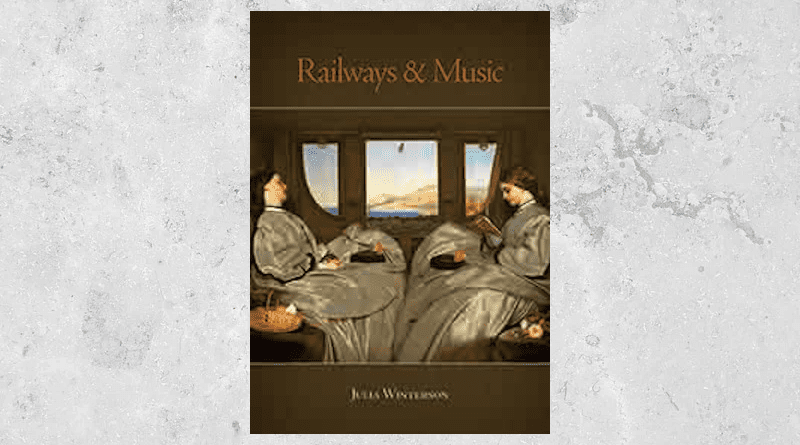New Book Explores Musical Inspiration Of The Railways
A new book by former University of Huddersfield lecturer Dr Julia Winterson has explored the links between railways and music for the first time.
In ‘Railways and Music’, which has been published by Huddersfield’s University Press, Dr Winterson examines the connections across a range of music from classical to country both in the musical content and lyrical themes. She has also recently written about the subject for the BBC’s Classical Music magazine.
Trains have inspired many memorable songs and movements, from the stories of hobos riding the rails in America to the sound of a train seemingly travelling from one speaker to another in David Bowie’s ‘Station to Station’.
Dr Winterson’s book describes over 50 classical pieces as well as over 250 popular songs, and is the first book that studies the ongoing cycle of railways and music in depth.
And as Dr Winterson explains, she has deep family connections to railways that helped inspire her into writing her new book.
“I’ve always been interested in railways, because as a child we had idyllic holidays at Pool in Wharfedale where my grandad was the stationmaster.
“It was a bit like something from ‘The Railway Children’, I was even allowed to operate the signals! I am from a railway family, my great-grandad was stationmaster at Hawes in North Yorkshire and other relatives worked as platelayers and clerks. It really is in the blood.”
But music, as well as railways, is also in Dr Winterson’s blood. After studying music at Huddersfield Polytechnic, she then attended the Royal Academy of Music as a postgraduate clarinettist before returning to Huddersfield to teach music at the town’s then Technical College.
She has subsequently worked for Edexcel, was Head of New Music for renowned music publishers Peters Edition and lectured on music at the University of Huddersfield. ‘Railways and Music’ is not her first publication, having written over 20 music textbooks, but it is a labour of love that the COVID-19 pandemic gave Dr Winterson the time to indulge in.
“I really enjoyed this as it gave me a chance to be more creative,” she adds. “Lockdown gave me all the time in the word to write it, which was lovely.”
“The coming of the railways changed society and changed everything. All over Europe, pieces of music were written for the opening of new lines. The Strauss family, for example, wrote many pieces for these kinds of occasions but oddly that didn’t happen in the UK. Maybe it was a kind of snobbery, but in the UK it was more the case that music hall songs referred to railways.
“In popular music, people are attracted by the notions of leaving and coming back and railways help to service that. In the US, the blues sprang from people leaving the south, going to Chicago and hankering for the past. The hobo tradition sees people always moving on, riding the trains, getting casual work wherever they go and going on to somewhere else.
“There are so many examples of trains and railways in music it was hard to know what to focus on. Tom Waits cultivated that hobo image, and he is obsessed with trains and collects train sounds. Bob Dylan has referenced railway imagery in his lyrics, and Captain Beefheart’s ‘Click clack’ sounds like a train motion from the very start in a way I have not really found anywhere else.
“I also found a really nice connection with John Cage, who my students and I were lucky enough to work on a project with at Huddersfield Technical College in 1989. In Cage’s piece Il treno, the railway is not only the subject of the composition, it also serves as the performance venue itself. On June 26, 1978 a three-day event began in Bologna Centrale Station.
“A stopping train filled with passengers, musicians and electronic music equipment embarked on its journey making stops at designated towns. Passengers were greeted by bands and dancers from the surrounding area, speakers relayed sounds from the local environment, and cassette recorders played unexpected sounds in random corners.”
Trains have also played a part in the history of music technology, with the train noises recorded by musique concrète pioneer Pierre Schaeffer at a Paris station in 1948 becoming the first known examples of sampling, a technique that revolutionised popular music in the latter half of the twentieth century.
“I came across a lot of fantastic music that I didn’t know about,” Dr Winterson admits. “There were also interesting snippets about composers who either loved or hated trains. Britten loved them and Rossini hated them, for example, and I discovered how well-known figures connected to trains were not always all that they seemed.
“In America, both Railroad Bill and Jesse James were often hailed as Robin Hood figures, and although Railroad Bill did occasionally donate his loot to the poor, in the case of Jesse James there was no truth in this characterization at all.
“Some American music imitates the train on fiddle or harmonica, and trains provide a blueprint for much classical music with a gradual acceleration, picking up speed, then slowing down. There are some fabulous recordings available out there.”

